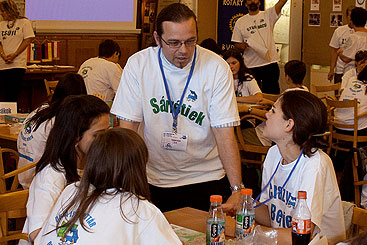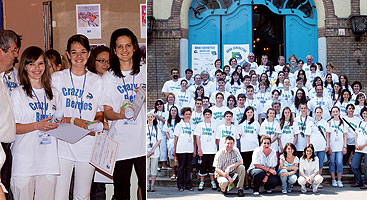
Putting the Danube Box to the test
Schools play a vital role in spreading environmental messages. And as more teachers look for ways to incorporate information about the Danube and its tributaries into their lessons, the Danube Box is proving to be a valuable tool to create awareness and understanding about the protection of this valuable resource.

From the 400 teams registered, 8 groups moved ahead to participate in the National Final in Budapest.
Hungary was the first to translate the Danube Box, and the Hungarian version, Duna Ismerettár, was launched at the beginning of the 2007/2008 school year with a nation-wide online competition at www.danubebox.hu. Organised by the Hungarian Ministry of Environment and Water and the Ministry of Education in cooperation with Global Water Partnership Hungary and supported by Coca-Cola Hungary, the competition challenged three-student teams, grades -1 , to test their Danube knowledge in river-related quizzes. Nearly 400 teams registered for the contest’s second year, and the winning teams and their teachers won a week in a camp in the Duna-Dráva National Park as the grand prize.
József Lengyel has been a geography teacher at Péter András Gimnázium and Szigeti Endre Szakkepző School for the last three years. He has been very involved in the Danube Box contest and was present at both last year’s final with two teams and this year’s with three teams. Both years his teams were among the top three winning groups.
The daNube box
The basin-wide educational kit, based on the principles and objectives of sustainability and environmental education, is made possible through cooperation with The Coca-Cola Company, Coca-Cola Hellenic and the ICPDR under the framework of the Green Danube Partnership. The Danube Box includes quizzes, teacher training, online competitions, interactive web journeys and many more inviting activities.
Some 10,000 kits (including handbook, poster, family cards, CD-ROM) and an additional 2,500 CD-ROMs (the full pack in digital version) have been produced and nearly all copies have already been distributed to schools. All national versions are available online and more than 7,000 visitors have downloaded the Danube Box in the last six months alone. Based on statistics collected on a voluntary basis with the online orders, the Danube Box has reached about 900,000 children.
For more information, please visit: www.danubebox.org
Danube Watch: How did you get involved with the
Danube Box competitions?
Lengyel: I found out from a colleague at the school
who looks up various calls for contests on the internet.
She immediately thought of me as she knows how
committed I am to natural science and environmentally-directed education. I first came in contact with the teaching kit when the school received it as part of
early registration for the first competition.
Danube Watch: How did you incorporate the project
work into your normal classes?
Lengyel: Unfortunately, because of the low number
of classes dedicated to natural science, I can only minimally
prepare children in class. Moreover, I can only
teach with the Danube Box when the class curriculum
includes subjects of river protection or river-related
issues. So we organised vocational classes in the
afternoons and, with some instruction, also had the
children prepare at home.
An important part of the preparation process was that the children had to act as a team and they managed this very well. Focusing on team work is important because while one might be better at recognising certain types of animals, another might learn the topography or cultural and economical issues more easily.
Danube Watch: How did the children respond?
Lengyel: It was easy to get the children interested as
they are all interested in nature and they are all thinking
of continuing their studies in the field of natural
sciences. Thus the Danube Box fits in perfectly.
There were a lot of students interested in the competition this year and we had enough interest for many more teams. But while there was no limit to the number of teams from school that could participate, we opted to keep the number of teams to three for efficiency reasons. The fact that all three of them made it to the finale supports our decision.

Lengyel has had three teams in the National Final in the last two years: Crazy Berries won first place in both years, and Z.I.R. and Sárrétiek have both made it into the top three teams.
Danube Watch: What effect has the Danube Box had
on students?
Lengyel: The children have become more interested
in natural science classes such as geography or biology through the competition. This is so important because
natural science classes tend to be put aside in favour
of social sciences.
What’s more, getting to know the Danube Box and learning from it has had a positive effect on the children’s approach to nature. This is also thanks to the fact that the package visually and engagingly presents the rivers, their fauna, the cultural differences and the social effects that belong to their environment. Although the Danube is quite far away from our town, we could clearly observe the characteristics of our surrounding rivers. The children have absolutely become more environmentally aware and they pay more attention to the waters and their usage.
Danube Watch: Has the Danube Box been used outside
the contest?
Lengyel: The package can easily be used in special
classes. For the moment, we try to apply the easier water-related tests; however, my biology and chemistry
colleagues and I intend to broaden these tests in the
future. Moreover, I try to introduce information related
to economy – such as industrial water usage – to
curricular classes.
As for the contest, I am absolutely satisfied with the present form – although I really couldn’t say otherwise since in the two previous contests we’ve had a team win First Place and another score a winning place!
However, I think it’s important to highlight that the first merit is that of the children who enthusiastically participate. If they didn’t study or weren’t so enthusiastic about it, even the most targeted preparation wouldn’t be worth anything at all.
Danube Watch: Thank you , and good luck next year!
Disclaimer
The information contained in the ICPDR website is intended to enhance public access to information about the ICPDR and the Danube River. The information is correct to the best of the knowledge of the ICPDR Secretariat. If errors are brought to our attention we will try to correct them.
The ICPDR, expert group members, nor other parties involved in preparation of information contained on this website cannot, however, be held responsible for the correctness and validity of the data and information provided, nor accept responsibility or liability for damages or losses arising directly or indirectly from the use of the information conveyed therein.
Only those documents clearly marked ICPDR documents reflect the position of the ICPDR.
Any links to other websites are provided for your convenience only. The ICPDR does not accept any responsibility for the accuracy, availability, or appropriateness to the user's purposes, of any information or services on any other website.
When using the information and material provided on this website, credit should be given to the ICPDR.
